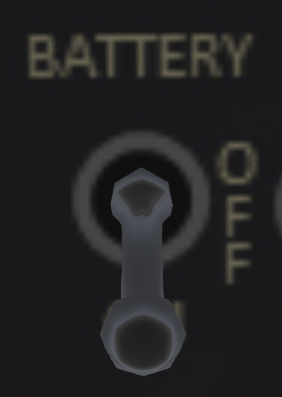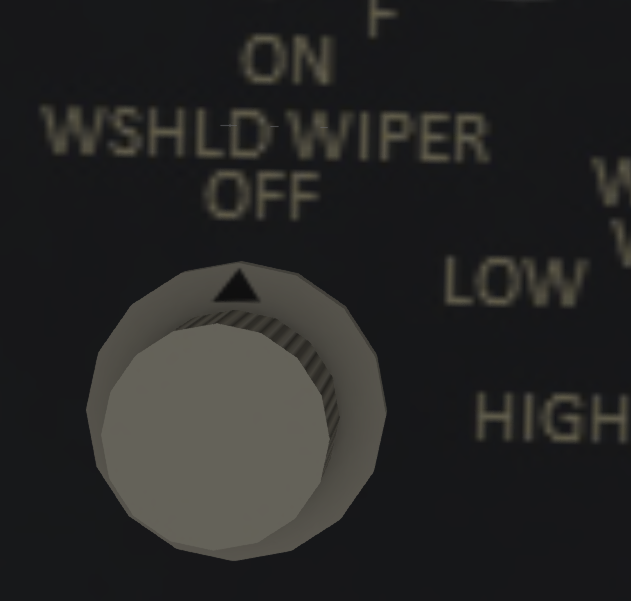Steamly S2-S/General
SECTION 1. GENERAL
1 N-NUMBER ASSIGNMENT
When you rez your aircraft for the first time, it will attempt to contact registration server and assign you a unique N-number. If for some reason the server cannot be contacted, the aircraft will retain the "N-TEMP" registration. You can attempt to register again either by rerezing the aircraft, or by going to the @REGISTER menu and selecting the [Register Now] button (click the glass bubble to access the menu). When an aircraft has not been registered, the @REGISTER will be available on the main menu. Once the aircraft is registered, you can access the @REGISTER menu as a sub-menu of the @Admin menu. You can also request a different N-number through the @REGISTER menu. Select the [N Number] button and enter an N-Number request. The N-number must be in a valid format, and must not be assigned to another aircraft. Valid N-Numbers must begin with an "N", followed by 3 to 5 alpha-numeric digits (however, only the last two digits may be letters). Alternatively you can select one of the international registration formats L-LLLL or LL-LLL where the "L" are letters. Your distribution also comes with a registration certificate. You can use this to fetch and display your registration information, but its use is optional and not required to assign or change N-numbers for your aircraft.
2 CONTROLS
This aircraft supports two separate control schemes. Control scheme 1 features a traditional layout with the cyclic controlled by the arrow keys, whereas control scheme 2 features a "two handed" layout with either both hands on the keyboard, or left hand on keyboard and right hand on the mouse. Regardless of the scheme selected, controls can also be moved through the HUD by pressing and holding the left mouse button and dragging the appropriate slider in the HUD. In both control schemes, some key commands are activated through gestures included in a box as part of the product carton. Key commands requiring a gesture are marked with a [G] in the key command lists below.
2.1 CONTROLS LAYOUT "K" (KEYBOARD)
Keyboard control features a traditional layout with the cyclic controlled by the arrow keys.
| Key | Description |
|---|---|
| Left/Right/Up/Down (or A/D/W/S) | cyclic (Left/Right/Forward.Back) |
| PgUp/PgDown (or E/C) | Collective (Up/Down) |
| L. Mouse + Left/Right (or A/D) | Pedals (left/right)* |
| Shift-Left/Shift-Right | Alternate pedal control (not available in mouselook) |
| Z/X | Alternate pedal keys (left/right) [G] |
- NOTE ON PEDALS: Because the left mouse button is intercepted by the touch scripts in the heli, the L.Mouse + Arrow key combination will only work in mouselook, or in external view modes. There is also a "mouselook touch" mode that is toggled by the "mlt" chat command. This toggles whether mouse clicks while in mouselook affect switches and buttons in the cockpit, or are used for pedals.
2.2 CONTROL LAYOUT "H" (HUD)
HUD control is designed to be used with the left hand on the WASD buttons, and right hand on the mouse controlling the cyclic in the HUD (by dragging the red dot on the HUD). It is also possible to use gestures for the JKLI buttons to control cyclic with the mode.
| Key | Description |
|---|---|
| Up/Down (or W/S) | Collective up/down. |
| Left/Right (or A/D) | Anti-torque pedals. |
| J/L/I/K | *Cyclic left/right/forward/back. [G] |
2.3 Gestures
The included gesture pack can be attached to enable the following additional keyboard commands:
| Key | Description |
|---|---|
| p | Toggle camera view [G] |
| q | Toggle fine control [G] |
| t | Toggle mouselook touch [G] |
| r/v | Throttle up/down [G] |
| y/n | Fuel flow up/down [G] |
| Z/X | Alternate pedal keys (left/right) [G] |
| J/L/I/K | Alternate cyclic left/right/forward/back. [G] |
| . | Center cyclic [G] |
3 CHAT COMMANDS
3.1 General
Chat commands may be issued on local chat, or on the channel /2973 for use in gestures.
3.2 Command Summary
| Command | Description |
|---|---|
| tm | Toggle master |
| tg | Toggle generator |
| tfp | Toggle fuel pump |
| tgov | Toggle governor |
| tb | Toggle beacon |
| tn | Toggle nav lights |
| tt | Toggle taxi light |
| tl | Toggle landing light |
| ti | Toggle instrument lights |
| mgo/mgr/mgl/mgb | Set magnetos to off/right/left/both |
| mx<n> | Set mixture where <n> is one or two digit number |
| rb<n> | Set rotor break where <n> is one or two digit number |
| th<n> | Set throttle where <n> is one or two digit number |
| cv | Toggle camera view |
| qstart | Do a quick start (skip full start procedure) |
| qstop | Do a quick shutdown (skip full shutdown procedure) |
| hud | Get copy of hud |
| poh | Get copy of POH (Pilot Operating Handbook) |
| fc | Toggle fine control |
3.3 Quick Start
Like all Shergood aircraft there is a command, "qstart", to start the helicopter quickly. In order to use this command, there must be someone sitting in the pilot seat. Note that the qstart command works by initiating a script that configures the helicopter for flight and does not instantly put the helicopter in a flyable state. The script includes pauses to wait for various systems to spin up to speed such as the APU, each engine and the rotor system. Once issuing the qstart command, it is recommended to wait for the rotor system to reach 100% before attempting flight.
The qstart command does not by default correct any failed systems. Some system failures may prevent the qstart process from completing. In this case, there will be a message in local chat informing that qstart has timed out. You can correct failed components either by clicking on the component or using the "Repair All" button from the "@Cheat" menu.
3.4 Fine Control
The "fc" chat command or "q" gesture toggles fine control mode for key commands. This can be useful when higher precision is need such as for making an accurate landing on a small platform. When in fine control mode, the effect of control keys are halved.
4 CAMERA
The default camera position is inside the cockpit with a view through the front glass. It is also possible to switch to an outside "follow cam" view. Wear the "cameraViews" gestures and use the "p" key to toggle views. In addition, it is possible to fly in mouselook when using one of the keyboard based flight control methods.
5 Switch Operation
5.1 General
The switch names can be used to control the switches from chat commands or gestures. The chat commands for the various switch types are described below.
5.1.1 Toggle switches
Toggle switches are simple two position switches, in most cases with an ON and OFF position (a small subset are selectors between two options). Commands for toggle switches are:
| Command | Description |
|---|---|
| s name | Toggle a switch |
| s1 name | Move a switch to the ON position. |
| s0 name | Move a switch to the OFF position. |
5.1.2 Three-Position Toggle Switches
The Pelican has a number of three-state "toggle" style switches (see Figure 2). The switch positions are numbered with "0" as the top position and "1" as the center position, and "3" as the edge positions. Toggles are moved by click over the area you want it to switch to, near the top for position 0, the center for position 1 and the bottom for position 2. They can be controlled with the following chat commands:
| Command | Description |
|---|---|
| s0 name | Move switch to top position |
| s1 name | Move switch to center position |
| s2 name | Move switch to bottom position |
5.1.3 Rotary Switches
Rotary switches have varying numbers of discrete positions and are controlled with a rotating knob. The positions are numbered start with zero at the most counter-clockwise position and increase in a clockwise direction. For example in the knob shown in the figure to the left the FWD setting is position 0, and the ALL setting is position 4. Knobs are moved interavtively by clicking on them. The side on which you click, relative to the indicating line, determines the direction of rotation.
| Command | Description |
|---|---|
| sn name | Set rotary switch to position n. |


